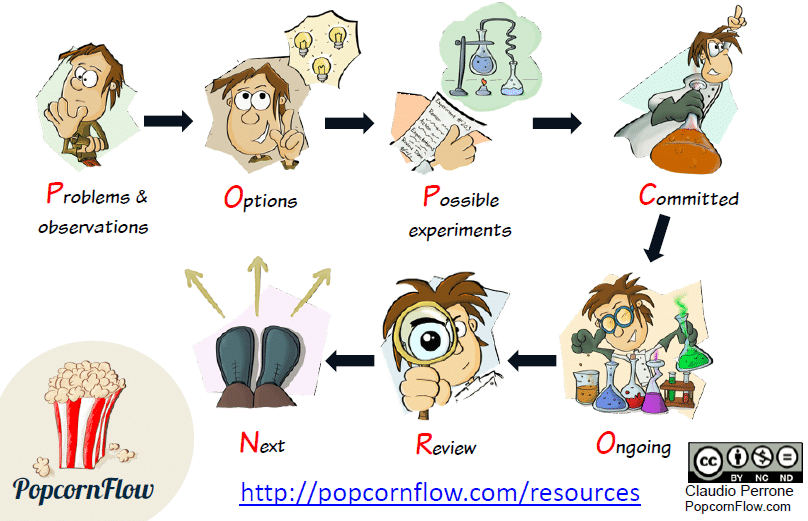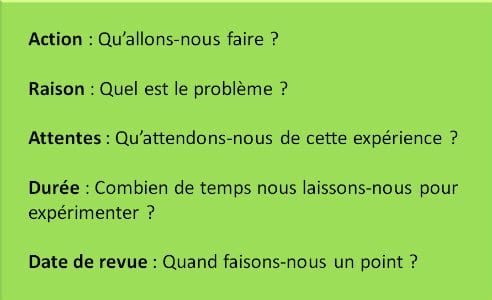During the last Lean Kanban France, November 3 and 4, 2015, Claudio Perrone presented PopcornFlow, a simple – yet powerful – continuous improvement tool to introduce rapid change and support better decision-making. On the occasion of his nomination for the Brickell Key Award 2016, I take this opportunity to review one of the public's favorite sessions and my meeting with a person whom I found humanly enriching.
My meeting with Claudio Perrone

To be completely honest, when I saw Claudio's photo in the program, I was not very reassured. The combination with the sound of his name gave me the impression that he would be a rather serious and hard to reach person. Go find out why!
As the organizer of Lean Kanban France 2015, we had the privilege of having dinner with the speakers the day before the event and it was to my great surprise that I discovered a very pleasant, relaxed person (in T- shirt), smiling and especially who is interested in others! This last element also took me a bit by surprise, as I follow rather discreetly in these cases.
I remember this question he asked me and which I am still trying to answer:
How should I introduce you if I wanted to tell others about you?
It is in this benevolent climate that we began to discuss about the profession of Coach (personal development) and the usefulness it could have in organizations.
That's when I got a quick PopcornFlow primer on the case of an executive who feels like he always has to do everything on his own. He explains to me that as a consultant, what he brings with him are models, experiences and options! I then realized that the approach was quite similar to the one I used in individual coaching, but above all it allowed me to summarize it in a few words: open the field of options for people. Thank you Claudio for this! 🙂
Like what, do not always rely on appearances and live the experience of meeting live before you get an idea! 🙂
Now let's get to the heart of the matter!
PopcornFlow
PopcornFlow is a method designed to introduce, sustain and accelerate change. Indeed, it starts from a simple observation:
Improving without changing is impossible.
The objective is then to create what Claudio calls a "Learning Stream" (what we learn as we go along) that we can possibly put in parallel with a "Value Stream" (what the we do to make money), usually achieved by a Kanban board. Claudio specified during his conference that he was suitable for being quoted, that's why I'm going to do it! 🙂
If all you learn is just practice, then you are a slave to practice.
If you understand the principles, then you are free to choose what works best for you.
In this sense, let's discover the principles underlying PopcornFlow to see if it suits us! 😉
1st Principle: the virus

When we talk about change, we can often see something huge, slow and scary – like Godzilla.
What if we could make it infinitely small and learn to evolve quickly – as quickly as a virus? Indeed, viruses have this resilience that means that they are constantly changing and mutating, generation after generation, whether or not a drug has been found to treat them.
If the change is difficult, make it continuous.
– 1st Principle of PopcornFlow (aka the "virus" principle)
We can feel the inspiration drawn from Kent Beck's eXtreme Programming with his “it's hard so let's do it some more”. In the same idea – even pushed a little further – it is to make change a habit so that it is no longer a source of suffering or difficulty. This also makes it possible to better apprehend it and to transform it into what one could call a non-event. Indeed, the more a thing is repeated, the less we pay attention to it!
Change the system

Taking this train of thought into account, it's as if we wanted to reconnect the brain in another way and that's difficult! It's like walking into a team and telling them to “self-organize! or tell their manager “become a servant leader!” ". It does not work – unfortunately – and we know it! 😉
One of the reasons is that people are often asked to change, but they are not given the means to do so. This is why another approach is to act on the system, where the decisions are taken but also where the problems are generated. In other words, it is not the issue that we will try to solve, but the system who produced it.
What matters is the process, not the result.

Claudio then tells the following story:
A reporter went to a Toyota factory and asked the managers:
Why do you allow your competitors to come into your factories and copy all your tools?
Managers then responded: What they need to see is not visible.
Kanban, Value Stream Mapping, 5S are only apparent solutions, results of Toyota's thought process, not the thought itself. As they say: all solutions are good, but not for everyone. Indeed, it is essential to understand the process that has enabled others to define a practice. A solution is nothing other than the result of a reflection applied in a given context, so be careful before copying practices outside your home.
That's not what we do but rather what we learn doing it that matters.
2nd Principle: the urgency of continuous improvement (kaizen)

Claudio talks here about the concept of inertia, our greatest enemy:
A tendency to do nothing or not change.
Again, when the change seems so huge to us, we tend to stay put. For what ? Simply because the risk of things getting worse is more scary than staying in an uncomfortable but known situation! Now if we look at the reaction to change rather than the change itself – making it more palpable – maybe that would have a better chance of succeeding.
Indeed, everyone can have an opinion on something to improve. Do we really need to have perfect information to be able to start progressing?
Everyone has the right to have an opinion, but… a shared opinion is a fact.
– 2nd Principle of PopcornFlow (aka the principle of "urgency for continuous improvement")
The idea is therefore to share your opinion on an element that you think should be improved in the team. If the team shares this opinion, then we can take it as a fact and start dealing with the problem. Indeed, instead of spending hours analyzing to find out if the problem is indeed a problem, let's experiment! Let us have an imperfect hypothesis, maybe we will converge together on a result that will suit us all! 😉
3rd Principle: the skateboarder

Can we really claim that we will never fail? How else can we view failure?
It is when we do not obtain a result that meets our expectations that we can feel the frustration of failure. However, observed from the Agile point of view, that is to say as learning, it can help us to generate another type of behavior.
We only truly fail when we limit our opportunities to learn.
And if life was like living on a skateboard, if you want to learn, well you have to try! So might as well prepare to fall!
The only people who never fall are those sitting on a bench watching their lives pass before them.
Thus comes the 3rd principle of PopcornFlow:
It's not "fail fast, fail often"...
It is “learns quickly, learns often”.
– 3rd Principle of PopcornFlow (aka the “skater” principle)
The process

Issues & Comments
First step, let's identify the problems or areas for improvement.
A problem brought up by a person is initially considered as an opinion, which is why you can write your name on the associated Post-it. Indeed, is this really a problem for the whole team? Let's check this first before committing to a resolution – which will cost us time and money no matter what.
If this opinion is shared, then it can be considered a fact (2 nd Principle of PopcornFlow). Even if the information is imperfect, we agree as a team to start studying it. We thus allow ourselves to be false, but above all we give ourselves the opportunity to come up with something that can ultimately bring us something.
Ex: "The team has communication problems", "The quality of the code is poor"...
Options
From the problem, it is time to generate options, solutions. Claudio evokes the "Rule of Three", not necessarily in the sense in which it is usually understood but in the sense of Virginia Satyr :
Having a choice is not a choice; having two choices is a dilemma; and having three choices opens up new possibilities. »
So, to keep the field of options open, make the effort to find at least 3! 😉
Note: As the facilitator, start by bringing out the options of others and then supplement them with your own so as not to reduce the group's creativity.
Ex: "Discuss with the team", "Do individual interviews", "Do TDD", "Do Pair Programming"...
Possible experiments
Based on the options, experiments are defined to explore them. Indeed, it is a subtle but crucial starting point from scientific thinking and Lean Startup.
Ex: "Let's have a team meeting every morning", "Let's do Pair Programming for 3 days"...
Commitment
We then select one or more experiments that we undertake to implement. We will obviously do everything in our power to make it work to guarantee learning, whatever it is!
To do this, we detail the experiments a little more:

It is important that expectations are measurable, either quantitatively or qualitatively. Indeed, you have to be able to easily answer the question: did it work?
Ex. of expectations: "The team wastes less time looking for information", "We have fewer bugs reported on average", "There is a better knowledge of the overall code"
Ongoing
It's time for experimentation! 😉
Review
Arrived at the review date, we take stock of the results of the experiment by comparing what we obtained with what we expected or hoped for.
Here are the types of questions you can ask yourself:
- What experiments did we plan to do?
- What did we actually do?
- What did we expect to happen?
- What really happened?
- What have we learned?
Note: This can also be done as part of retrospectives.
After (Next)
Based on what we learned, what are we going to do next?
Several options are then available to us:
- The results are not obvious, maybe it deserves to be extended for X days/weeks!
- Let's re-evaluate our options!
- Let's re-evaluate our experiments!
- Choose new experiments!
- Are there others that we hadn't thought of before?
- Let's re-evaluate our problem!
Why does it work?

PopcornFlow helps people engage with their issues rather than just talking about them. This is another way to visualize and materialize ideas / problems in this case by writing them on Post-its and moving them on a board. I often use it today as a support for discussions in workshops whether with a technical team or with managers and I think I would even use it in individual coaching if it allows the client to better structure his ideas.
One of the great strengths of PopcornFlow is that it can be applied in any field as soon as there is a desire to learn and improve. Indeed, it brings the idea that we can evolve and help others to do so, in a world today in perpetual motion.
What is exciting about introducing options into our way of doing and seeing things is that the question is no longer to do or not to do something but rather to choose the option that seems to us the best !
That's not what we do but rather what we learn doing it that matters. But then…
That's not what we learn, but rather what we do with what one learns that matters.
–Claudio Perrone
See also
- THE site dedicated to PopcornFlow
- There keynote performed at Lean Kanban France 2015
- An excellent article on the SOAT's blog






